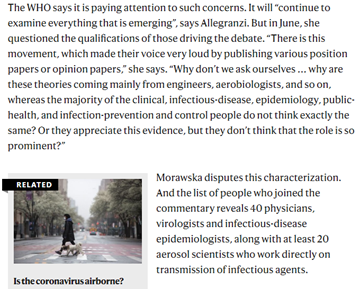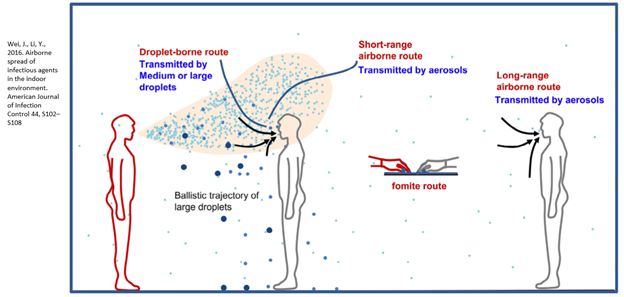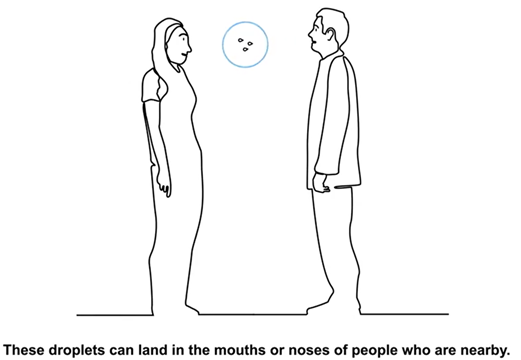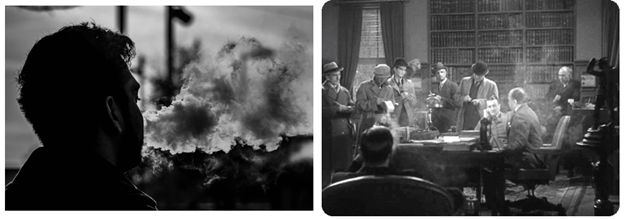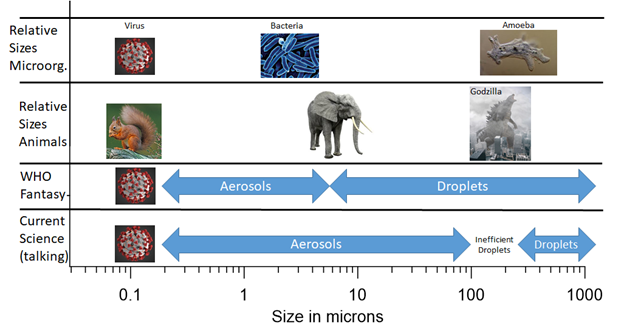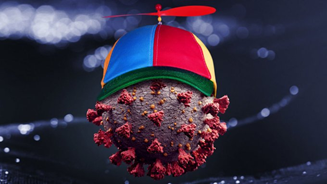1/ On the need for a **true multidisciplinary approach** to aerosol & droplet transmission (aka “the Godzilla thread”)
2/ This thread is offered constructively to point out a problem & suggest a needed change (with a little bit of humor sprinkled in). I hope it is taken on that spirit.
I don’t know how to make these points without criticizing some past statements or pointing out key major errors
I don’t know how to make these points without criticizing some past statements or pointing out key major errors
3/ Transmission of diseases by aerosols and droplets is a complex problem, and one that is naturally multidisciplinary.
It certainly needs to involve infectious disease specialists, epidemiologists, virologists and... aerosol (and related) scientists, on an equal footing.
It certainly needs to involve infectious disease specialists, epidemiologists, virologists and... aerosol (and related) scientists, on an equal footing.
4/ Scientific diversity may seem common sense, but it is not widely practiced
IMHO a lack of scientific diversity in key high places is a major reason why we are in this predicament.
@jeremyphoward has also worked with @WHO & expressed similar opinion https://twitter.com/jeremyphoward/status/1290768909209964544">https://twitter.com/jeremypho...
IMHO a lack of scientific diversity in key high places is a major reason why we are in this predicament.
@jeremyphoward has also worked with @WHO & expressed similar opinion https://twitter.com/jeremyphoward/status/1290768909209964544">https://twitter.com/jeremypho...
5/ There are multiple instances in which WHO personnel and key committee members have dismissed our group of 239 scientists as e.g. “chemists, engineers, and owners of ventilation companies”
https://www.livescience.com/coronavirus-airborne-transmission-debate.html">https://www.livescience.com/coronavir...
https://www.livescience.com/coronavirus-airborne-transmission-debate.html">https://www.livescience.com/coronavir...
6/ @Don_Milton, a medical doctor co-leading the effort to convince WHO of the importance of aerosol transmission, was amused when I told him he must be an ”owner of a ventilation company”, since he obviously is not a chemist nor an engineer!
7/ Similarly a key WHO staff member wondered why the information about aerosol transmission was coming from engineers, aerobiologists and so on.
Nature pointed out this was a mischaracterization, but dismissal of our expertise as less relevant was clear. https://www.nature.com/articles/d41586-020-02058-1">https://www.nature.com/articles/...
Nature pointed out this was a mischaracterization, but dismissal of our expertise as less relevant was clear. https://www.nature.com/articles/d41586-020-02058-1">https://www.nature.com/articles/...
8/ The subtext that emerges from these and many other interactions (including many here in Twitter), and from the composition of the WHO personnel and key committee, is that in this debate some disciplines are more important than others.
9/ Epidemiology etc. are more important, and aerosol science is secondary, perhaps unclear if much to contribute
@WHO told us they were interested in our input on ventilation. But implied message was that for disease transmission, they had it under control and we were not needed.
@WHO told us they were interested in our input on ventilation. But implied message was that for disease transmission, they had it under control and we were not needed.
10/ Let’s analyze this.
To understand aerosol and droplet transmission, clearly we need to know:
- where the virus load is in infected patients and whether it is viable
- where the receptors are in susceptible people, their infectious dose and many other aspects
To understand aerosol and droplet transmission, clearly we need to know:
- where the virus load is in infected patients and whether it is viable
- where the receptors are in susceptible people, their infectious dose and many other aspects
11/ But, there is a **critical, sine-qua-non** part of the process of infection that involves the **travel of particles (aerosols and ballistic droplets) through the air.**
12/No matter how many viruses come out of an infected person or how easily the virus initiates infection, **there can be no infection if viruses don’t reach the target receptor**
Travel through the air is not less important than the other parts, **it is just as important.**
Travel through the air is not less important than the other parts, **it is just as important.**
13/ Travel through the air is realm of aerosol science. Aerosol sci. is complex.
People used to raindrops and the visible ballistic droplets from coughs. WHO, CDC and others tell us that droplets move ballistically and fall to the ground in 1-2 m (3-6 ft), like in “angry birds”
People used to raindrops and the visible ballistic droplets from coughs. WHO, CDC and others tell us that droplets move ballistically and fall to the ground in 1-2 m (3-6 ft), like in “angry birds”
14/ WHO’s video is starkly clear about this, as are other sources: https://twitter.com/WHO/status/1244258441880797184">https://twitter.com/WHO/statu...
This is why WHO says that no masks are needed indoors if a distance of 1 m can be kept ( https://www.who.int/news-room/q-a-detail/q-a-how-is-covid-19-transmitted#).">https://www.who.int/news-room... And, I think, this is why many are so confused about masks.
This is why WHO says that no masks are needed indoors if a distance of 1 m can be kept ( https://www.who.int/news-room/q-a-detail/q-a-how-is-covid-19-transmitted#).">https://www.who.int/news-room... And, I think, this is why many are so confused about masks.
15/ Smaller, invisible aerosols float in the air and behave in less obvious ways. The best analogy is cigarette smoke, which is an aerosol. Think about (or experiment with) how smoke moves, and dilutes, and you can get the gist of what is going on.
16/ Again, understanding how the infectious payload is delivered through the air from the infected to the susceptible person is a critical problem, and if we don’t invest enough effort on it and engage the experts, we can get it seriously wrong.
17/ Aerosol scientists would seem needed, but perhaps @WHO already understands this well and doesn’t need the help? Let’s investigate if that’s the case.
18/ As of this writing WHO’s latest scientific briefing ( https://who.int/publications/i/item/modes-of-transmission-of-virus-causing-covid-19-implications-for-ipc-precaution-recommendations)">https://who.int/publicati... states that aerosol-droplet boundary is 5 um.
Same in a recent paper from the members of the key WHO committee ( https://aricjournal.biomedcentral.com/articles/10.1186/s13756-020-00779-6)">https://aricjournal.biomedcentral.com/articles/...
Same in Klompas et al. in JAMA ( https://jamanetwork.com/journals/jama/fullarticle/2768396)">https://jamanetwork.com/journals/...
Same in a recent paper from the members of the key WHO committee ( https://aricjournal.biomedcentral.com/articles/10.1186/s13756-020-00779-6)">https://aricjournal.biomedcentral.com/articles/...
Same in Klompas et al. in JAMA ( https://jamanetwork.com/journals/jama/fullarticle/2768396)">https://jamanetwork.com/journals/...
19/ But the real boundary between ballistic droplet behavior (falls within 1-2 m, infects by impact) and aerosol behavior (travels > 2 m, infects by inhalation at any distance) is at around ~100 um.
Stay tuned about what caused the 5 um error, coming soon to a preprint near you
Stay tuned about what caused the 5 um error, coming soon to a preprint near you
20/ The real aerosol-droplet boundary is discussed in multiple published papers, going back to Wells (1934): https://academic.oup.com/aje/article/20/3/611/280025
See">https://academic.oup.com/aje/artic... also: https://onlinelibrary.wiley.com/doi/10.1111/j.1600-0668.2007.00469.x">https://onlinelibrary.wiley.com/doi/10.11...
See">https://academic.oup.com/aje/artic... also: https://onlinelibrary.wiley.com/doi/10.1111/j.1600-0668.2007.00469.x">https://onlinelibrary.wiley.com/doi/10.11...
21/ But it is even worse, to be able to reach others at distances of 0.5-1m when talking, ballistic droplets need to be >300 um.
Work by Yuguo Li (invited presenter at WHO 900-person webinar 2 weeks ago) https://www.sciencedirect.com/science/article/abs/pii/S0360132320302183),">https://www.sciencedirect.com/science/a... similar independent work https://aip.scitation.org/doi/10.1063/5.0021427">https://aip.scitation.org/doi/10.10...
Work by Yuguo Li (invited presenter at WHO 900-person webinar 2 weeks ago) https://www.sciencedirect.com/science/article/abs/pii/S0360132320302183),">https://www.sciencedirect.com/science/a... similar independent work https://aip.scitation.org/doi/10.1063/5.0021427">https://aip.scitation.org/doi/10.10...
22/ It took 50 tweets to explore the 100 um vertical motion and 300 um horizontal motion thresholds in detail, so I’ll refer you to the previous "angry birds" thread: https://twitter.com/jljcolorado/status/1292880342227984385">https://twitter.com/jljcolora...
23/ Aerosol and droplet motion is a dramatic function of size, since mass increases with the cube of the diameter. So I decided to make it visual. It is hard to overstate how large of an error @WHO and others are making.
24/ If the virus is the size of a squirrel, WHO is saying that droplets start at the size of an elephant. But really, droplet behavior starts at the size of Godzilla! ( https://www.popularmechanics.com/culture/movies/a10476/the-impossible-anatomy-of-godzilla-16785535/)">https://www.popularmechanics.com/culture/m...
25/ The relative error in size is as large as if aerosol scientists confused virus w/ bacterium, or (larger) bacterium w/ amoeba
And responses we often get are the equivalent of us making those errors & saying “microbe, schmicrobe”.
For many ppl does seem “microns, schmicrons”
And responses we often get are the equivalent of us making those errors & saying “microbe, schmicrobe”.
For many ppl does seem “microns, schmicrons”
26/ Limited understanding of aerosols appears again and again in a series of “myths”:
(a) If it’s aerosol, it has to be like measles
(b) If it’s aerosol, it has to infect at long range
(c) If infects at close proximity, it proves droplets and disproves aerosols
(a) If it’s aerosol, it has to be like measles
(b) If it’s aerosol, it has to infect at long range
(c) If infects at close proximity, it proves droplets and disproves aerosols
27 (myths continued)
(d) If it’s aerosol, then surgical masks are useless
(e) If it’s aerosol, R0 must be very high
(d) If it’s aerosol, then surgical masks are useless
(e) If it’s aerosol, R0 must be very high
28/ Those myths are all false, as I’ve discussed before ( #vp_1">https://www.medscape.com/viewarticle/934837?src=uc_mscpedt&faf=1 #vp_1).">https://www.medscape.com/viewartic...
These myths are often implicitly or explicitly applied to interpret the results of studies in very complex situations, leading to incorrect conclusions.
These myths are often implicitly or explicitly applied to interpret the results of studies in very complex situations, leading to incorrect conclusions.
29/ Indeed “This issue is more nuanced than many of them realize” (quote from a @WHO committee member) is perhaps also true in the opposite direction.
30/ Hospital CEO: "When our children get sick, we call a pediatrician. If our roof leaks, we call a roofer. And if we& #39;re having problems with our teeth, we do not call the auto mechanic, we call a dentist who has been trained to take care of that problem” https://twitter.com/jljcolorado/status/1295016533849018369">https://twitter.com/jljcolora...
31/ So when aerosols could be involved in transmission, and the results of evaluating whether they do or don& #39;t have huge implications...
shouldn’t aerosol scientists be deeply involved in the studies and committees that will make that determination?
shouldn’t aerosol scientists be deeply involved in the studies and committees that will make that determination?
32/ Our message about 5 um error has been heard.
So the new way to deal with it seems to be to say something like: “It is recognized that there is a continuum of transmission routes between large droplet and aerosol and it is an important concept.” https://aricjournal.biomedcentral.com/articles/10.1186/s13756-020-00779-6">https://aricjournal.biomedcentral.com/articles/...
So the new way to deal with it seems to be to say something like: “It is recognized that there is a continuum of transmission routes between large droplet and aerosol and it is an important concept.” https://aricjournal.biomedcentral.com/articles/10.1186/s13756-020-00779-6">https://aricjournal.biomedcentral.com/articles/...
33/ This seems to allow stretching droplets into what I call “magical droplets”, entities that allow explaining outbreaks, but are still firmly droplets (and thus don’t require recognizing aerosol transmission).
But they don’t seem to have clearly defined properties such as size
But they don’t seem to have clearly defined properties such as size
34/ Liberated from the tyranny of size, their amazing behavior allows explaining any superspreading event without having to give up that COVID-19 is a droplet/fomite disease.
May I offer a visual for the “magical droplets” ;-)
https://www.theonion.com/researchers-warn-coronavirus-may-use-propeller-hat-to-s-1844282753">https://www.theonion.com/researche...
May I offer a visual for the “magical droplets” ;-)
https://www.theonion.com/researchers-warn-coronavirus-may-use-propeller-hat-to-s-1844282753">https://www.theonion.com/researche...
35/ Why people resorting to magical droplets?
Thomas Kuhn in “Structure of Scientific Revolutions” ( https://www.uky.edu/~eushe2/Pajares/Kuhn.html):
"Scientists">https://www.uky.edu/~eushe2/P... faced w/ failing theory “devise numerous articulations & ad hoc modifications of their theory in order to eliminate any apparent conflict”
Thomas Kuhn in “Structure of Scientific Revolutions” ( https://www.uky.edu/~eushe2/Pajares/Kuhn.html):
"Scientists">https://www.uky.edu/~eushe2/P... faced w/ failing theory “devise numerous articulations & ad hoc modifications of their theory in order to eliminate any apparent conflict”
36/ In this case the ad hoc modifications take the shape of partially acknowledging some clear aerosol transmission, but still cast it as an extension of droplet behavior. And thus removing the need to more clearly admit aerosol transmission.
37/ Droplet transmission is failing to explain the observations at a massive scale ( #slide=id.p">https://docs.google.com/presentation/d/11rY9tQtkFaV_M4N-hf5qp1_Xtuw8JYb4Qvv5e7BEmcc/edit #slide=id.p),">https://docs.google.com/presentat... from the reduction of transmission outdoors, to superspreading events
E.g. in 41 outbreaks in bars in Louisiana , w/ 11 cases per outbreak: https://twitter.com/jljcolorado/status/1294490285712396289">https://twitter.com/jljcolora...
E.g. in 41 outbreaks in bars in Louisiana , w/ 11 cases per outbreak: https://twitter.com/jljcolorado/status/1294490285712396289">https://twitter.com/jljcolora...
38/ So I’ll end with a plea. We are in this pandemic together. The different disciplines need to work together to understand the modes of transmission and interpret evidence. I had to offer some criticisms and point out some major errors in this thread.
39/ Never before COVID-19 had ever done anything like this. I hope I can stop criticizing very soon, because the relevant bodies will have taken a new attitude and created more scientifically diverse teams to attack these complex problems.
https://twitter.com/threadreaderapp/status/1295530227322376192?s=19">https://twitter.com/threadrea...

 Read on Twitter
Read on Twitter

